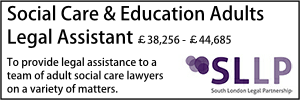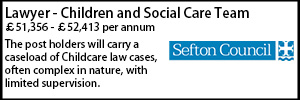Court of Appeal hits out at “hugely burdensome” routine requests for clarification of judgments in care cases
- Details
The Court of Appeal has issued a reminder to practitioners that receiving a judge's draft judgment in care cases is “not an ‘invitation to treat’, nor is it an opportunity to critique the judgment or to enter into negotiations with the judge as to the outcome or to reargue the case in an attempt to water down unpalatable findings”.
Giving the judgment in I (Children) [2019] EWCA Civ 898 Lady Justice King, with whom Lord Justice Singh and Lord Justice Bean agreed, added: “Requests for clarification should not be routine and should only be made in accordance with the Practice Note which I repeat is: ‘to raise with the judge and draw to his attention any material omission in the judgment, any genuine query or ambiguity which arises on the judgment, and any perceived lack of reasons or other perceived deficiency in the judge's reasoning process.’”
She said it was neither necessary nor appropriate for the Court of Appeal to seek to identify any bright line or to provide guidelines as to the limits of the appropriate nature or extent of clarification which may properly be sought in either children or financial remedy cases.
The appeal related to a ruling by Her Honour Judge Bancroft in a case centring around two unexplained skull fractures sustained by a baby who was only 15 weeks old.
At the centre of the appeal was the judge's finding in relation to the second, right-hand side, fracture. HHJ Bancroft held:
"133. In my judgment all this set the context for a sudden loss of control resulting in an injury to A inflicted or caused by an anxious, stressed mother. Alternatively, and there is some evidence for this from M herself in her police interview and in the children's reported conversations in the car [that] she left A unattended and was downstairs at the time."
No additional light was thrown upon this finding (paragraph 133) by reference to the judge's findings in respect of the earlier left-sided fracture. So far as that fracture was concerned, the judge found (at paragraph 136) that the left-sided fracture was an older injury, was not a birth injury and which, on the balance of probabilities, occurred whilst A was in the mother's care.
The Court of Appeal was concerned with one ground of appeal allowed to be pursued by the mother, namely that “in reaching the conclusion that there are two potential explanations for the injury the learned judge has failed to make a determination of facts."
Lady Justice King said the mother, the local authority and the Guardian "notwithstanding some helpful clarification by the judge”, were all agreed that the appeal in relation to that ground must be allowed by consent.
The issue for the Court of Appeal was to consider the proper order to make upon the appeal being allowed, consideration of which necessarily involved an examination of events following the conclusion of the trial and the handing down of the judgment.
Counsel for the mother proposed that paragraph 133 be amended to add the following words at the end of the paragraph: "Consequently, I am unable to reach a clear finding as to what caused the right-hand fracture and it remains unexplained."
However, Lady Justice King accepted the submissions of counsel for the local authority that:
- determination of how A's right-sided head injury was caused was necessary to lead to a "fair and comprehensive assessment of the mother as a future carer for the children";
- from the point that the mother admitted that she had concealed the truth as to what had occurred on 27 May 2018, a re-hearing was necessary and inevitable;
- the mother's new explanation did not permit substituted findings of "unexplained" [as to what caused the right-hand fracture] to be made. The mother's new account needed to be tested in the conventional way in the interest of justice to all the parties.
Lady Justice King said the appeal had thrown up two further areas of concern:
a) The extent of clarification of the judgment requested on behalf of the mother, which dealt with minor typographical errors and an error of attribution before raising a number of additional points requesting further explanations from HHJ Bancroft;
b) The filing of the mother's statement between receipt of the draft judgment and handing down of the judgment.
Reviewing the case law and the Family Procedure Rules in relation to requests for clarification, Lady Justice King said: “In my view, the exhortations as to the limitations on counsel in seeking amplification of a draft judgment over and above correction of typographical and factual errors, is a principle which applies equally to all areas of civil procedure, including family cases. The Practice Note in Re A and another (Children) (Judgment: Adequacy of Reasoning) [2012] 1 WLR 595, saying in terms at [16] that it is the responsibility of the advocate to raise with the judge ‘any material omission in the judgment, any genuine query or ambiguity which arises on the judgment and any perceived lack of reasons or other perceived deficiency in the judge's reasoning process’ is not, in my view, inconsistent with Lord Judge's observations in R (Mohamed) v Foreign Secretary (No 2)(CA) [2010] 3 WLR 554.
“The question, rather, is as to where one draws the line between a reasonable and appropriate request for amplification of the type identified by Munby LJ in the Practice Note, which request will properly be an example of the rare occasions where it is appropriate to go beyond typographical and factual errors in order to clarify issues in a judgment, as against a request which goes beyond the Practice Note and seeks to reargue the case. Unhappily, to my knowledge, such requests can, on occasion, be frankly confrontational and disrespectful in tone.”
Lady Justice King said judgments in care cases were often given by a judge under immense time pressure whether extemporary or reserved. It was right that issues of the type identified in the Practice Note should be raised with the judge if appropriate and, in so doing, avoid the necessity of an appeal and therefore further delay for the child the subject of care proceedings, she said.
But the Court of Appeal judge said counsel for the mother had “confirmed the perception of this Court that requests for extensive clarification, going well beyond the perimeters identified in the authorities, have become commonplace in both children and financial remedy cases in the Family Court. It has become, as we understand it, almost routine for a draft judgment to be followed up with extensive requests for 'clarification' which in many cases can be regarded as nothing other than an attempt to reargue the case or, as here, water down the judge's judgment; successfully in this case by the removal of the words "such as an intemperate throw or a drop rather than a crudely inflicted injury" from the critical paragraph 133.”
Lady Justice King said that with respect to [the mother’s counsel], who had been helpful and pragmatic in all his submissions, while the request for clarification submitted by him was “by no means the most excessive the Court has seen, it is, in my judgment, on the wrong side of the line”.
The Court of Appeal judge added: “The family court is overwhelmed with care cases. Judges at all levels often move seamlessly from one trial to the next without judgment writing time between them. Routine requests for clarification running to a number of pages are not only ordinarily inappropriate, but hugely burdensome on the judges who have, weeks later, to revisit the evidence and their judgment when their thoughts and concerns have long since moved onto other cases. This is not conducive to the interests of justice.”
Lady Justice King said: “It is neither necessary nor appropriate for this court to seek to identify any bright line or to provide guidelines as to the limits of the appropriate nature or extent of clarification which may properly be sought in either children or financial remedy cases.
“I would merely remind practitioners that receiving a judge's draft judgment is not an 'invitation to treat', nor is it an opportunity to critique the judgment or to enter into negotiations with the judge as to the outcome or to reargue the case in an attempt to water down unpalatable findings. Requests for clarification should not be routine and should only be made in accordance with the Practice Note which I repeat is: ‘to raise with the judge and draw to his attention any material omission in the judgment, any genuine query or ambiguity which arises on the judgment, and any perceived lack of reasons or other perceived deficiency in the judge's reasoning process.’”
On the second area of concern, the filing of the mother's statement between receipt of the draft judgment and handing down of the judgment, Lady Justice King said it was undoubtedly the case that, from time to time, new evidence would emerge following the conclusion of a trial and prior to judgment being handed down.
The issue is as to what the proper approach is when such evidence emerges, she said. “One thing is clear, namely that such 'fresh evidence' should never be confused with nor regarded as part of the clarification process discussed above.
“Immediately fresh, and potentially relevant, evidence is brought to the attention of a party, it is their duty to inform and provide the evidence to all the other parties in the case. Any statements subsequently drafted and upon which a party wishes to rely must be served on all the parties and absent express consent in writing, should not be sent to the judge.”
Lady Justice King said that in the event that a party wished to make an application that the judge should delay the handing down of judgment in order to consider whether, and if so to what extent, there should be further evidence in the case, proper notice should be given to both the judge and the parties in order to enable the judge to have a directions hearing and to hear submissions from all sides.
“It is for the judge then to determine, using his or her case management powers what, if any, steps should be taken to consider the fresh evidence. The unusual nature of the present case has meant that this court, having considered the judgment as it stands, has determined that there must be a retrial. Such an outcome is by no means inevitable, and indeed might be regarded as unlikely, where an alleged perpetrating parent files a statement by which they completely change their story between receipt of a draft judgment and the handing down of the same judgment. [Counsel for the mother], rightly, did not seek to appeal the judge's refusal to delay handing down her judgment in the present case.”
Lady Justice King said the appeal would be allowed by consent and the matter remitted for a retrial, which trial she had been told would be heard by the Family Division Liaison Judge for the Northern Circuit in a few weeks' time.





















































